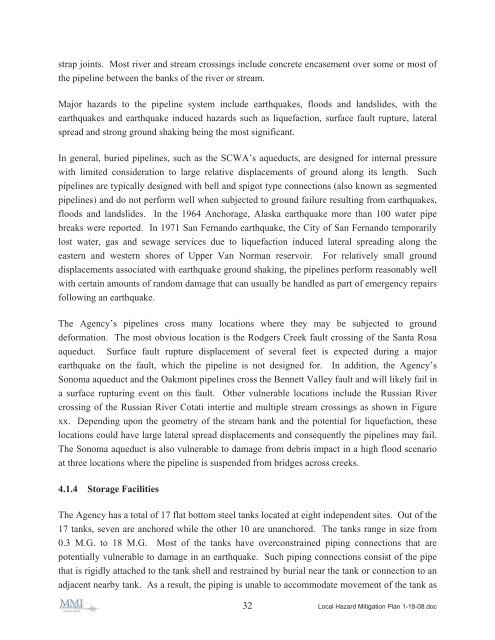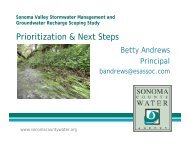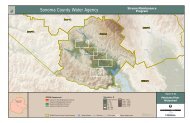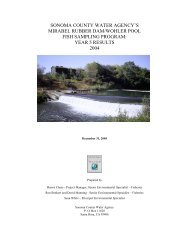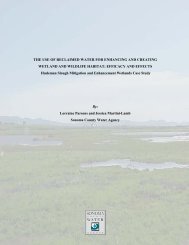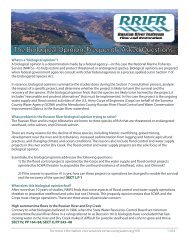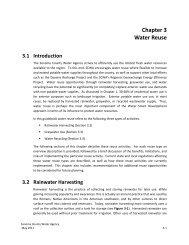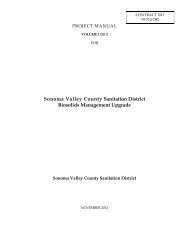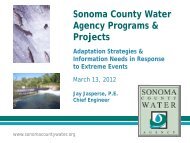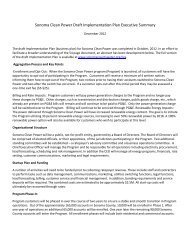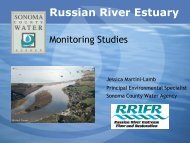Local Hazard Mitigation Plan.pdf - Sonoma County Water Agency ...
Local Hazard Mitigation Plan.pdf - Sonoma County Water Agency ...
Local Hazard Mitigation Plan.pdf - Sonoma County Water Agency ...
Create successful ePaper yourself
Turn your PDF publications into a flip-book with our unique Google optimized e-Paper software.
strap joints. Most river and stream crossings include concrete encasement over some or most of<br />
the pipeline between the banks of the river or stream.<br />
Major hazards to the pipeline system include earthquakes, floods and landslides, with the<br />
earthquakes and earthquake induced hazards such as liquefaction, surface fault rupture, lateral<br />
spread and strong ground shaking being the most significant.<br />
In general, buried pipelines, such as the SCWA’s aqueducts, are designed for internal pressure<br />
with limited consideration to large relative displacements of ground along its length. Such<br />
pipelines are typically designed with bell and spigot type connections (also known as segmented<br />
pipelines) and do not perform well when subjected to ground failure resulting from earthquakes,<br />
floods and landslides. In the 1964 Anchorage, Alaska earthquake more than 100 water pipe<br />
breaks were reported. In 1971 San Fernando earthquake, the City of San Fernando temporarily<br />
lost water, gas and sewage services due to liquefaction induced lateral spreading along the<br />
eastern and western shores of Upper Van Norman reservoir. For relatively small ground<br />
displacements associated with earthquake ground shaking, the pipelines perform reasonably well<br />
with certain amounts of random damage that can usually be handled as part of emergency repairs<br />
following an earthquake.<br />
The <strong>Agency</strong>’s pipelines cross many locations where they may be subjected to ground<br />
deformation. The most obvious location is the Rodgers Creek fault crossing of the Santa Rosa<br />
aqueduct. Surface fault rupture displacement of several feet is expected during a major<br />
earthquake on the fault, which the pipeline is not designed for. In addition, the <strong>Agency</strong>’s<br />
<strong>Sonoma</strong> aqueduct and the Oakmont pipelines cross the Bennett Valley fault and will likely fail in<br />
a surface rupturing event on this fault. Other vulnerable locations include the Russian River<br />
crossing of the Russian River Cotati intertie and multiple stream crossings as shown in Figure<br />
xx. Depending upon the geometry of the stream bank and the potential for liquefaction, these<br />
locations could have large lateral spread displacements and consequently the pipelines may fail.<br />
The <strong>Sonoma</strong> aqueduct is also vulnerable to damage from debris impact in a high flood scenario<br />
at three locations where the pipeline is suspended from bridges across creeks.<br />
4.1.4 Storage Facilities<br />
The <strong>Agency</strong> has a total of 17 flat bottom steel tanks located at eight independent sites. Out of the<br />
17 tanks, seven are anchored while the other 10 are unanchored. The tanks range in size from<br />
0.3 M.G. to 18 M.G. Most of the tanks have overconstrained piping connections that are<br />
potentially vulnerable to damage in an earthquake. Such piping connections consist of the pipe<br />
that is rigidly attached to the tank shell and restrained by burial near the tank or connection to an<br />
adjacent nearby tank. As a result, the piping is unable to accommodate movement of the tank as<br />
32 <strong>Local</strong> <strong>Hazard</strong> <strong>Mitigation</strong> <strong>Plan</strong> 1-18-08.doc


